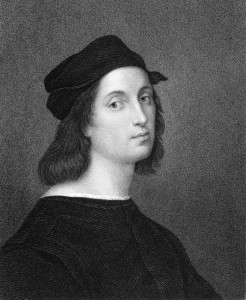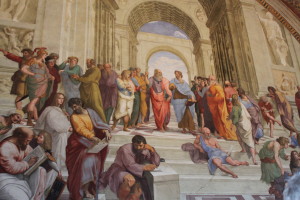Who Is Raphael? A Brief Look at the Artist.
 If Leonardo da Vinci was the Renaissance’s great mad scientist and Michelangelo was its master of grandeur and drama, then Raphael Sanzio da Urbino was the embodiment of the Renaissance’s elegance and grace. Born in the city of Urbino in 1483, Raphael was surrounded by art from an early age. His father, the court painter to the Duke of Urbino, taught him the basics of painting. It was clear from the beginning that he was a prodigy. He caught the eye of the successful Renaissance painter Perugino, and at the age of 17 Raphael left Urbino for Perugia to spend four years studying in Perugino’s studio. His meteoric rise to stardom continued, and at the age of 21 he began spending time in Florence, the artistic center of the Renaissance. There Raphael gained inspiration from Leonardo da Vinci and Michelangelo, gracefully adopting elements of their styles while producing works that were distinctly his own. In 1508 Pope Julius II commissioned Raphael to paint a series which would include his magnum opus, The School of Athens. Raphael spent his remaining years in Rome under the patronage of Julius II and his successor, Leo X. He continued to paint some of his greatest works and even delved into architecture after Leo X made him chief architect of the Vatican. Raphael died unexpectedly on April 6, 1520 at the age of 37. Although the true cause of his death is unknown, it was supposedly his notoriously excessive sexual habits that brought on his illness.
If Leonardo da Vinci was the Renaissance’s great mad scientist and Michelangelo was its master of grandeur and drama, then Raphael Sanzio da Urbino was the embodiment of the Renaissance’s elegance and grace. Born in the city of Urbino in 1483, Raphael was surrounded by art from an early age. His father, the court painter to the Duke of Urbino, taught him the basics of painting. It was clear from the beginning that he was a prodigy. He caught the eye of the successful Renaissance painter Perugino, and at the age of 17 Raphael left Urbino for Perugia to spend four years studying in Perugino’s studio. His meteoric rise to stardom continued, and at the age of 21 he began spending time in Florence, the artistic center of the Renaissance. There Raphael gained inspiration from Leonardo da Vinci and Michelangelo, gracefully adopting elements of their styles while producing works that were distinctly his own. In 1508 Pope Julius II commissioned Raphael to paint a series which would include his magnum opus, The School of Athens. Raphael spent his remaining years in Rome under the patronage of Julius II and his successor, Leo X. He continued to paint some of his greatest works and even delved into architecture after Leo X made him chief architect of the Vatican. Raphael died unexpectedly on April 6, 1520 at the age of 37. Although the true cause of his death is unknown, it was supposedly his notoriously excessive sexual habits that brought on his illness.
Raphael’s Masterpiece | “Marriage of the Virgin”
A number of Raphael’s greatest works are in Italy still. The Marriage of the Virgin, painted early in his career for the church of San Francesco, Città di Castello, was inspired by Perugino. It is a wonderful example of his own budding talent, with its careful attention to perspective and the gentle, natural poses of the figures as opposed to the stiffness that was popular in Perugino’s heyday. Today the Marriage of the Virgin stands in the Pinacoteca di Brera in Milan.
Raphael’s Masterpiece | “Entombment of Christ”
 The Entombment of Christ marks a transition in his career. Preparing for the painting, he studied Perugino’s Lamentation of Christ but he began branching out and studying the work of other artists, especially that of Michelangelo. Michelangelo’s influence brought a new sense of tragedy and drama into Raphael’s Entombment. The painting is now housed in the Galleria Borghese in Rome. The Triumph of Galatea is one of the finest examples of High Renaissance painting. Commissioned by a wealthy banker for his summer house in Rome, this one has an easy, playful feeling. The figures are in Michelangelo-inspired poses, but Raphael gave them a grace that only he could pull off. Galatea is still in its original home at the Villa Farnesina in Rome.
The Entombment of Christ marks a transition in his career. Preparing for the painting, he studied Perugino’s Lamentation of Christ but he began branching out and studying the work of other artists, especially that of Michelangelo. Michelangelo’s influence brought a new sense of tragedy and drama into Raphael’s Entombment. The painting is now housed in the Galleria Borghese in Rome. The Triumph of Galatea is one of the finest examples of High Renaissance painting. Commissioned by a wealthy banker for his summer house in Rome, this one has an easy, playful feeling. The figures are in Michelangelo-inspired poses, but Raphael gave them a grace that only he could pull off. Galatea is still in its original home at the Villa Farnesina in Rome.
In few of his paintings did Raphael channel Michelangelo’s spirit with as much elegance and grace as in The School of Athens, his masterpiece. While Raphael was working on his first series of paintings in the Vatican, Michelangelo was in the midst of painting his legendary Sistine Chapel frescoes. Against Michelangelo’s will, architect Donato Bramante gave Raphael a sneak peak of Michelangelo’s progress. Raphael was blown away. The grandiosity deeply influenced his treatment of The School of Athens. Italians saw the ancient Greek intellectual and artistic achievements as the very height of humanity, and he painted recognizable contemporary figures (including Michelangelo and himself) among them. He brought a sense of wonder and exploration into the scene. The painting is one sweeping statement that he and his fellow Italians had brought humanity to those great heights again. Five centuries later it stands just where he painted it in the Vatican in Rome.
The Great Rivalry | Raphael vs Michelangelo
 Michelangelo did not always take kindly to Raphael borrowing his style. In fact, Michelangelo claimed that Raphael owed all of his success to him. The two were natural rivals: Michelangelo was stormy and grumpy, while Raphael was easygoing and charming. Michelangelo’s life was filled with turbulent relationships, and he tended to isolate himself. Raphael lived a vibrant social life. He was well liked and respected, both for his art and for his personality. Michelangelo showed little interest in Raphael’s work, at least outwardly. Raphael made no effort to hide his interest in the work of Michelangelo or that of any of his fellow artists. He was a master of imitating his peers while injecting his own flavor into the mix. No matter how similar the technical details like the poses of his figures were to those in Michelangelo’s paintings, only Raphael could paint people with such sensitivity and easy vitality.
Michelangelo did not always take kindly to Raphael borrowing his style. In fact, Michelangelo claimed that Raphael owed all of his success to him. The two were natural rivals: Michelangelo was stormy and grumpy, while Raphael was easygoing and charming. Michelangelo’s life was filled with turbulent relationships, and he tended to isolate himself. Raphael lived a vibrant social life. He was well liked and respected, both for his art and for his personality. Michelangelo showed little interest in Raphael’s work, at least outwardly. Raphael made no effort to hide his interest in the work of Michelangelo or that of any of his fellow artists. He was a master of imitating his peers while injecting his own flavor into the mix. No matter how similar the technical details like the poses of his figures were to those in Michelangelo’s paintings, only Raphael could paint people with such sensitivity and easy vitality.
It is this serene humanity that Raphael is ultimately remembered for as an artist. Although the artistic trends of Mannerism and the Baroque favored Michelangelo’s excessive style immediately after Raphael’s death, artists who didn’t approve of these over-the-top styles looked to Raphael as the perfect counterpoint. Interest in his art picked up in the late 17th century and his influence even surpassed that of Michelangelo. To this day Raphael is held as the standard of the balanced artist. He remains the master of restraint, harmony, and grace.

